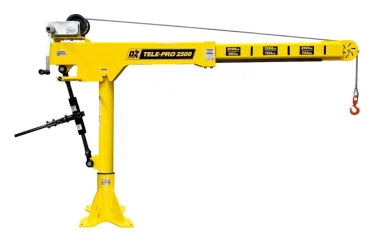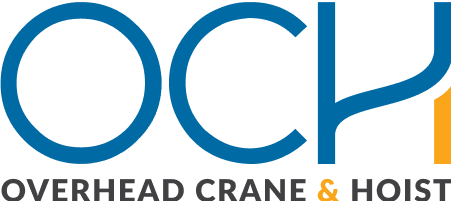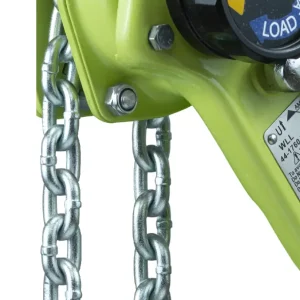
The Tele-Pro, available in 500 lb., 1,200 lb. and 2,500 lb. capacities, allows users to leverage the benefits of the company’s other davit cranes, while telescoping the boom in and out under load. All lifting specifications, hook reach, and lifting heights remain the same — but five improvements have been made: smoother boom operation under load; enhanced maneuverability; clearer capacity limits; industrial, high-visibility powder coat; and simplified maintenance.
Smoother boom operation under load: Inspired by cutting-edge technology and advanced testing, engineers have developed a smoother, more consistent telescoping experience, even under load. The improved telescoping boom allows for use in an even wider range of applications.
Enhanced maneuverability: A new handle has been added, specifically designed for easier load rotation. This gives users more precise control, while rotating the load 360°. The original version did not include a rotational handle. Based on successful implementation of a style of handle on the XR Series and CompOZite davit cranes, it was decided to incorporate a similar unit into this upgrade.
Clearer capacity limits: A new dual rating decal system provides both imperial and metric load capacities at different boom angles. These were added to enhance global accessibility and improve readability. OZ Lifting is working to implement dual ratings on the full product line, across manuals, decals, website, and ratings with both imperial and metric measurements.
Industrial, high-visibility powder coat: The range has been transitioned from a zinc-plated finish to a durable, corrosion-resistant, exterior-grade powder coat in high-visibility yellow. This finish extends the life of the crane and adds increased visibility, making it easier to see in a workspace, especially in low-light conditions.
Notably, the original Tele-Pro featured imperial capacity ratings engraved in the inner boom. To increase visibility and ease of use, the new capacity limit decals and yellow powder coat, ensure that operators can quickly and accurately identify the maximum load capacity of the boom to maximize safety and efficiency.
Simplified maintenance: Top and bottom grease zerk fittings have been added to the boom for easier lubrication, smoother operation, and simplified maintenance.
“These improvements were driven by a combination of customer feedback and our engineers’ dedication to staying current with technological advancements. In other words, feedback inspired these improvements, which were implemented through our engineers’ innovative use of new technology. We are always reevaluating and improving our products, but this is the most comprehensive relaunch we have completed to date,” said Richard Miller, sales manager, OZ Lifting.
“Enhancements of our products for low-light conditions is a good example of that combined innovation. Underground locations, such as tunnels or mines, industrial warehouses, and factories with limited lighting, all provide operational challenges, as do some construction sites, shipyards, and / or utility plants.”
Already off the production line is the relaunched 2,500 lb. capacity version; developed first as it represents the most complex engineering challenge. By starting with the largest capacity, OZ Lifting engineers have already begun the process of scaling down to the smaller 500 lb., 1,200 lb. models, which will be available in the coming months.
Many of the features that make the Tele-Pro davit crane range so widely popular remain central to the improved models. Fundamentally, the telescoping boom can be adjusted using a winch handle or drill drive adapter, while a ratchet binder adjusts the vertical boom angle. Smart latch technology remains at boom / mast connection, and no tools are required for assembly and installation. Pedestal, wall-mount, socket, and wheel bases are sold separately; users can utilize the old and new style Tele-Pro interchangeably with existing bases.
Miller reiterated there is no requirement for existing users to replace their older Tele-Pros. The models already in the field are still high-quality and will perform well for many years to come. Recent updates enhance safety, user experience, and design, as part of a wider commitment to innovation and continuous improvement.





